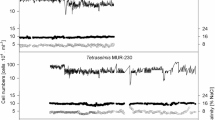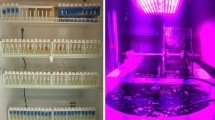Abstract
The microalgal industry as a source of high-value products (i.e. β-carotene, astaxanthin) was established over 50 years ago. However, only a very small number of species have been commercialised. There is a need for new species and new products to expand this industry. The objective of this study was to examine the reliability and productivities of long-term outdoor culture of a newly isolated halophilic diatom, Amphora sp. MUR258 (Bacillariophyceae), in raceway ponds in Perth, Western Australia. The Amphora sp. was grown in outdoor raceway ponds as a semi-continuous culture for about 13 months at a culture salinity between 8.6 and 14.9% (w/v) NaCl. The highest cell density (167 × 104 cells mL−1), specific growth rate (0.29 day−1) and biomass and lipid productivities (24 and 6.8 g m−2 day−1, respectively) were achieved in summer. The annual average of biomass (ash-free dry weight) and lipid productivities was 7 and 2.2 g AFDW m−2 day−1, respectively. Minor contamination by a Navicula sp. was seen during winter, but was not a significant problem. No major protozoan contamination was seen. These results indicate the potential of reliable large-scale cultivation of Amphora sp. MUR258 as a potential source of diatom lipid and/or fucoxanthin.





Similar content being viewed by others
References
Andersen RA, Kawachi M (2005) Traditional microalgae isolation techniques. In: Andersen RA (ed) Algal culturing techniques. Elseviser Academic Press, London, pp 83–100
Badour SS, Gergis MS (1965) Cell division and fat accumulation in Nitzschia sp. grown in continuously illuminated mass cultures. Arch Microbiol 51:94–102
Borowitzka MA (2005) Culturing microalgae in outdoor ponds. In: Andersen RA (ed) Algal culturing techniques. Elsevier, London, pp 205–218
Borowitzka MA (2013) Species and strain selection. In: Borowitzka MA, Moheimani NR (eds) Algae for biofuels and energy. Springer, Dordrecht, pp 77–89
Borowitzka MA (2018) Commercial-scale production of microalgae for bioproducts. In: La Barre S, Bates SS (eds) Blue biotechnology: production and use of marine molecules, vol 1. Wiley-VCH, Weinheim, pp 33–65
Borowitzka MA, Moheimani NR (2013a) Open pond culture systems. In: Borowitzka MA, Moheimani NR (eds) Algae for biofuels and energy. Springer, Dordrecht, pp 133–152
Borowitzka MA, Moheimani NR (2013b) Sustainable biofuels from algae. Mitig Adapt Strateg Glob Chang 18:13–25
Boruff BJ, Moheimani NR, Borowitzka MA (2015) Identifying locations for large-scale microalgae cultivation in Western Australia: a GIS approach. Appl Energy 149:379–391
Clavero E, Hernández-Mariné M, Grimalt Joan O, Garcia-Pichel F (2008) Salinity tolerance of diatoms from thalassic hypersaline environments. J Phycol 36:1021–1034
Collyer DM, Fogg GE (1955) Studies on fat accumulation by algae. J Exp Bot 6:256–275
DasSarma S, Arora P (2001) Halophiles. Encyclopedia of life sciences. Nat Publ Group 8:458–466
Evans JH (1958) The survival of fresh-water algae during dry periods. Part 1. An investigation of the algae of 5 small ponds. J Ecol 46:149–167
Fon Sing S, Isdepsky A, Borowitzka MA, Lewis DM (2014) Pilot-scale continuous recycling of growth medium for the mass culture of a halotolerant Tetraselmis sp. in raceway ponds under increasing salinity: a novel protocol for commercial microalgal biomass production. Bioresour Technol 161:47–54
Fukao T, Kimoto K, Kotani Y (2012) Effect of temperature on cell growth and production of transparent exopolymer particles by the diatom Coscinodiscus granii isolated from marine mucilage. J Appl Phycol 24:181–186
Gong Y, Hu H, Gao Y, Xu XH, Gao H (2011) Microalgae as platforms for production of recombinant proteins and valuable compounds:progress and prospects. J Ind Microbiol Biotechnol 38:1879–1890
Griffiths MJ, Harrison STL (2009) Lipid productivity as a key characteristic for choosing algal species for biodiesel production. J Appl Phycol 21:493–507
Guillard RRL, Ryther JH (1962) Studies of marine planktonic diatoms. I. Cyclotella nana Hustedt and Detonula confervacea (Cleve) Gran. Can J Microbiol 8:229–238
Imada N, Kobayachi K, Tahara K (1991) Production of an autoinhibitor by Skeletonema costatum and its effect on the growth of other phytoplankton. Nippon Suisan Gakkaishi 57:2285–2290
Indrayani I (2017) Isolation and characterization of microalgae with commercial potential. PhD thesis Murdoch University, Perth
Jorgensen EG (1956) Growth-inhibiting substances formed by algae. Physiol Plant 7:712–726
Khatoon H, Banerjee S, Yusoff FM, Shariff M (2010) Effects of salinity on the growth and proximate composition of selected tropical marine periphyric diatoms and cyanobacteria. Aquac Res 41:1348–1355
Lewin JC, Guillard RR (1963) Diatoms. Annu Rev Microbiol 17:373–414
Lombardi AT, Wangersky PJ (1995) Particulate lipid class composition of three marine phytoplankters Chaetoceros gracilis, Isochrysis galbana (Tahiti) and Dunaliella tertiolecta grown in batch culture. Hydrobiologia 306:1–6
Matsumoto H, Shiroji N, Hamasaki A, Ikuta Y, Fukuda Y, Sato M, Endo N, Tsukamoto (1995) Carbon dioxide fixation by microalgae photosynthesis using actual flue gas discharge from a boiler. Appl Biochem Biotechnol 51:681–692
Matsunaga T, Matsumoto M, Maeda Y, Sugiyama H, Sato R, Tanaka T (2009) Characterization of marine microalga, Scenedesmus sp. strain JPCC GA0024 toward biofuel production. Biotechnol Lett 31:1367–1372
McGinnis KM, Dempster TA, Sommerfeld (1997) Characterization of the growth and lipid content of the diatom Chaetoceros muelleri. J Appl Phycol 9:19–24
Moheimani NR (2013) Long-term outdoor growth and lipid productivity of Tetraselmis suecica, Dunaliella tertiolecta and Chlorella sp (Chlorophyta) in bag photobioreactors. J Appl Phycol 25:167–176
Moheimani NR (2016) Tetraselmis suecica culture for CO2 bioremediation of untreated flue gas from a coal-fired power station. J Appl Phycol 28:2139–2146
Moheimani NR, Borowitzka MA (2006) The long-term culture of the coccolithophore Pleurochrysis carterae (Haptophyta) in outdoor raceway ponds. J Appl Phycol 18:703–712
Moheimani NR, Borowitzka MA (2011) Increased CO2 and the effect of pH on growth and calcification of Pleurochrysis carterae and Emiliania huxleyi (Haptophyta) in semicontinuous cultures. Appl Microbiol Biotechnol 90:1399–1407
Moheimani NR, Isdepsky A, Lisec J, Raes E, Borowitzka MA (2011) Coccolithophorid algae culture in closed photobioreactors. Biotechnol Bioeng 108:2078–2087
Moheimani NR, Borowitzka MA, Isdepsky A, Fon Sing S (2013) Standard methods for measuring growth of algae and their composition. In: Borowitzka MA, Moheimani NR (eds) Algae for biofuels and energy. Sopringer Dordrecht, pp 265–284
Myklestad S (1977) Production of carbohydrates by marine planktonic diatoms. II. Influence of the NP ratio in the growth medium on the assimilation ratio, growth rate, and production of cellular and extracellular carbohydrates by Chaetoceros affinis var. willei (Gran) Hustedt and Skeletonema costatum (Grev.) Cleve. J Exp Mar Biol Ecol 29:161–179
Payer HD, Pithakpol B, Nguitragool M, Prabharaksa C, Thananunkul D, Chavana S (1978) Major results of the Thai-German microalgae project at Bangkok. Arch Hydrobiol Beih 11:41–55
Popovich CA, Damiani C, Constenla D, Leonardi PI (2012) Lipid quality of the diatom Skeletonema costatum and Navicula gregaria from the South Atlantic Coast (Argentina): evaluation of its suitability as biodiesel feedstock. J Appl Phycol 24:1–10
Radmer RJ, Parker BC (1994) Commercial application of algae: opportunities and constraints. J Appl Phycol 6:93–98
Ramachandra TV, Mahapatra DM, Karthick B (2009) Milking diatoms for sustainable energy: biochemical engineering versus gasoline-secreting diatom solar panels. Ind Eng Chem Res 48:8769–8788
Richmond A (1986) Ourdoor mass cultures of microalgae. In: Richmond A (ed) Handbook of microalgal mass culture. CRC Press, Boca Raton, pp 285–330
Roessler PG (1990) Environmental control of glycerolipid metabolism in microalgae: commercial implications and future research directions. J Phycol 26:393–399
Wang H, Zhang Y, Chen L, Cheng W, Liu T (2018) Combined production of fucoxanthin and EPA from two diatom strains Phaeodactylum tricornutum and Cylindrotheca fusiformis cultures. Bioprocess Biosyst Eng 41:1061–1071
Zittelli GC, Biondi N, Rodolfi L, Tredici MR (2013) Photobioreactors for mass production of microalgae. In: Richmond A, Hu Q (eds) Handbook of microalgal culture, applied phycology and biotechnology. Wiley Blackwell, UK, pp 225–266
Acknowledgments
Special thanks to the members of the Algae R&D Centre at Murdoch University for their support during the study.
Funding
This study was financially supported by Murdoch University. Indrayani received an Australian Development Scholarship (ADS).
Author information
Authors and Affiliations
Corresponding author
Additional information
Publisher’s note
Springer Nature remains neutral with regard to jurisdictional claims in published maps and institutional affiliations.
Rights and permissions
About this article
Cite this article
Indrayani, I., Moheimani, N.R. & Borowitzka, M.A. Long-term reliable culture of a halophilic diatom, Amphora sp. MUR258, in outdoor raceway ponds. J Appl Phycol 31, 2771–2778 (2019). https://doi.org/10.1007/s10811-019-01803-y
Received:
Revised:
Accepted:
Published:
Issue Date:
DOI: https://doi.org/10.1007/s10811-019-01803-y




